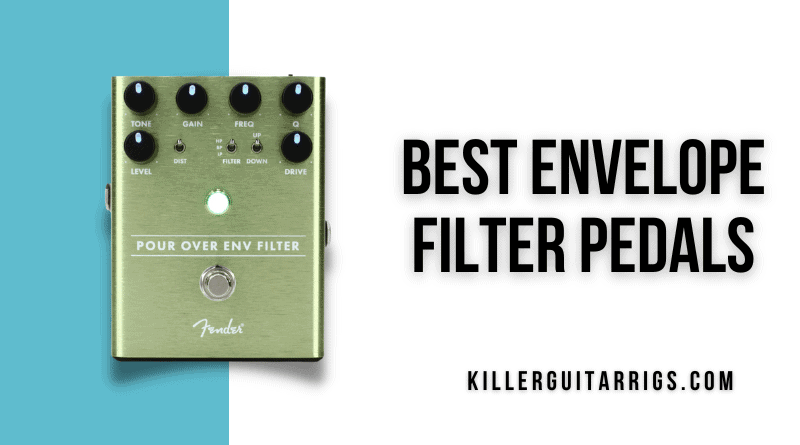If you’re expanding your pedal board and want something a bit different, an envelope filter pedal will give you some really unique, and almost experimental tones – one of the best in our opinion is the Fender Pour Over. This is an outstanding pedal, that, on top of the standard envelope circuitry, also offers built in drive, giving it even more versatility. It’s highly responsive to playing dynamics, and offers a choice of lowpass, bandpass, or highpass filter modes, serving up some really interesting tones and fantastic auto wah. Its anodized aluminum chassis is built to last, and it really looks great on any pedal board. Thanks to this laundry list of specs and features, we really think it did everything necessary to earn our Top Pick award.
Players looking for something really unique need to check out the Way Huge Attack Vector Smalls. This is a 2-in-1 pedal, with both phaser shifter and filter effects. It comes with true hard wired bypass to ensure signal integrity when the unit is off, and a simple toggle switch is used to change between the 2 effects. With the filter engaged, it serves up an almost vocal tonal quality, and of course, it features the kind of touch sensitive auto wah that attracts most players to this kind of pedal. There’s an LED indicator that provides visual feedback, which is great for anybody who plays in busy mixes. The Way Huge Attack Vector Smalls works with both guitar and bass, and delivers big in terms of texture. The build and sound quality are both fantastic, and because of its high end performance, we’ve named it as our Editor’s Choice.
Anybody looking for an envelope filter on a tight budget should think long and hard about investing in an Electro-Harmonix Nano Q-Tron. This is a compact, and easy to use FX unit, and does a great job with classic auto wah effects. It’s designed with simplicity in mind, featuring a basic (but effective) 4 knob control layout, making it easy to dial in the perfect tone without overcomplicating things with advanced settings and switches. It’s a rugged pedal, with an all metal nano sized body, making it perfect for anybody who doesn’t have much room to work with on their pedal board. This is a super affordable choice, and it was a no brainer for our Best Budget award.
Read more about our review process.
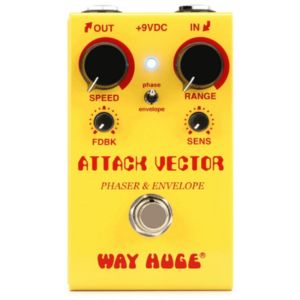
Way Huge Attack Vector Smalls Phaser and Envelope
Features: LED indicator, True bypass, Macro controls
Benefits: Ultra fine tonal control, Uses minimal pedalboard space, Super low noise
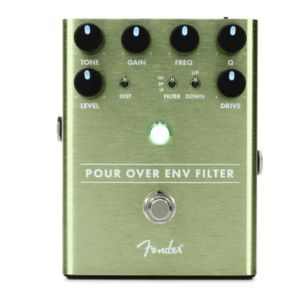
Fender Pour Over Envelope Filter
Features: Anodized aluminum chassis, Integrated drive circuit, Switchable filter modes
Benefits: Huge range of sounds, Fantastic build quality, Rich harmonics
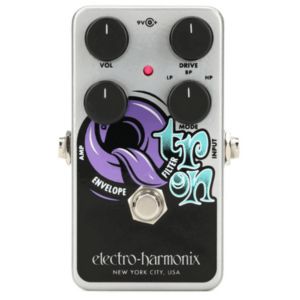
Electro-Harmonix Nano Q-Tron Envelope Filter
Features: All metal construction, Rotary filter mode switch, DC/Battery power options
Benefits: Ultra small footprint, Smooth effect delivery, Great touch sensitivity
Contents
Individual Reviews
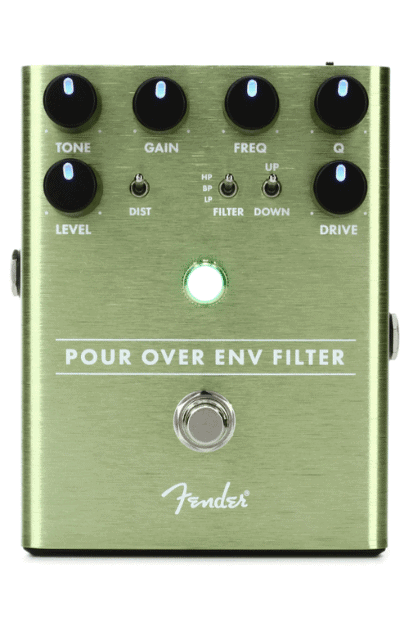
Fender Pour Over
Durability and high quality from a legendary brand.
No surprise that Fender tops the bunch with a pedal that is highly responsive, offers a wide range of filtering bands, and gave us some really killer tones.
The Fender Pour Over comes with switchable lowpass, bandpass, and highpass filter modes to offer a nice variety of auto-wah sounds. The first thing we liked about this pedal is how well-built it is, ready to take a beating on the road.
We set up Fender Pour Over along with our Strat and Twin Reverb in order to run our tests. We liked the simple layout of this pedal and started by setting it on high-pass filter mode on a clean tone. This pedal gave us a great response to our playing dynamics while providing a useful and tasteful auto-wah effect.
We also tried the lowpass and bandpass modes (while playing with the Frequency and Q knobs) and loved the variety they gave us. After playing in clean for a while, we activated the Distortion switch and set the Drive knob to about 11 o’clock. Here we got a nice overdriven bite that added very useful grittiness to our tone, perfect for a variety of situations.
When pushed, the Drive control added some nice harmonic richness to our tone. We spent a while discovering how the Frequency, Tone, Q, and Drive controls interact and got everything from very useful tones to some unique textures.
In short, a fantastic pedal that’s easy to use, intuitive, durable, and very responsive to your playing.
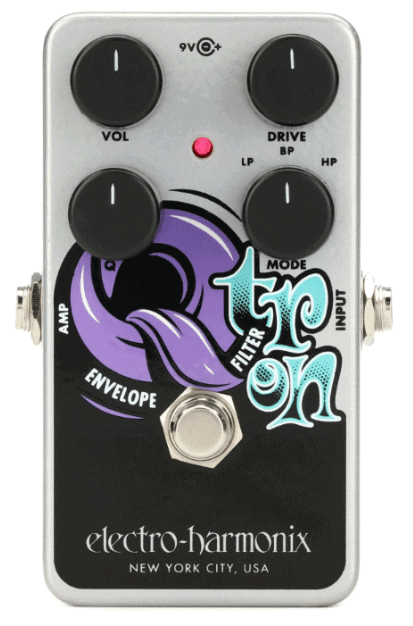
Electro-Harmonix Nano Q-Tron
A simpler version of a classic pedal, at an affordable price.
This pedal is Electro-Harmonix's response to folks that wanted Jerry Garcia-style auto-wah sounds but did not want to deal with the extensive options and massive size of the original Q-Tron pedal. The Nano Q-Tron offers an ideal compromise at a great price.
The Electro-Harmonix Nano Q-Tron gives the user dynamic-controlled wah-wah sounds much like its predecessor, but in a simpler and more compact form factor that easily fits in a pedalboard. And at a more attractive price tag.
We tried this pedal with our Gibson Les Paul and our Twin Reverb. During our tests, our favorite feature was the harder we would pick, the wider the frequency sweep we got. Conversely, when picking softly, we got a much more subtle effect. This makes the Nano Q-Tron a very musical and expressive pedal, which are two of the most important features in just about any piece of gear.
With only four knobs, this pedal still managed to give us variety, thanks mostly to its three selectable filters: lowpass, band-pass, and highpass. We had tons of fun switching through them while using the Drive control to dial in the sensitivity and filter sweep range.
On the other hand, the Q control allowed us to control the bandwidth of the filter. We were able to go from a smooth and subtle effect to a much funkier and in-your-face auto-wah tone with a simple turn of the Q knob.
Another great feature of this pedal is the true-bypass switching, as well as a very durable and rugged chassis, as is customary with Electro Harmonix pedals. In short, an affordable, compact, and overall fantastic auto-wah that delivers the goods while being able to easily fit in your pedalboard.
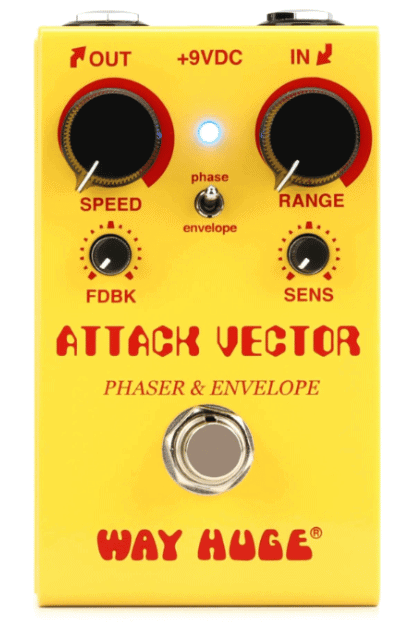
Way Huge Smalls Attack Vector Phaser and Envelope
Not only a twofer - but a good one!
The Way Huge Smalls Attack Vector Phaser and Envelope pedal offers players two different effects in a compact stompbox pedal. You get quality phase shifting plus a filter effect in a streamlined design that comes with just four knobs and a phase/envelope switch.
We tried the Way Huge Attack Vector Smalls Phaser and Envelope with our Strat and Fender Twin Reverb, starting by using it conservatively, for more conventional uses. For instance, with the 2-way switch on the Down position, we got a very responsive auto-wah type of sound by playing with the knobs at low levels.
We then started employing the Range and Sens knobs more aggressively to go into widely experimental territory. Naturally, the Range knob controls the filter range, while the Sens knob takes care of the sensitivity.
With the 2-way knob on the Up position, we got a nice phaser effect that was very useful, especially when we kept the Speed and Feedback knobs below the 12 o’clock position. Just like the envelope effect, the phaser was also very responsive to our playing and dynamics.
Besides being well-built and compact, the Attack Vector comes with a true hard-wire bypass for preserving your signal’s integrity and easy-to-grab controls and knobs that allow us to carry out precise and quick adjustments.
In short, a superior pedal that’s ideal for discerning musicians. Not only do you get two quality effects that are highly responsive to your playing, but the added convenience of having a standard-size stompbox that doesn’t take up much space or current.
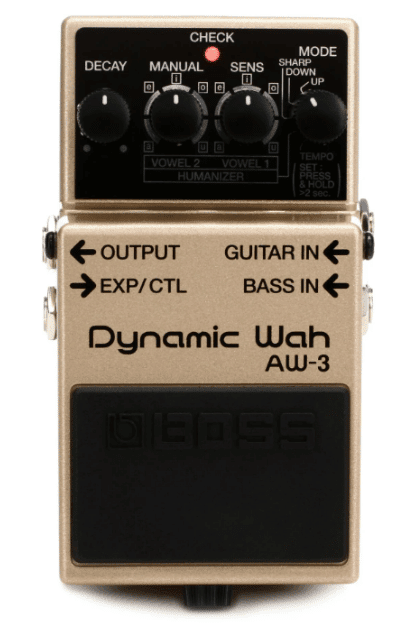
Boss AW-3 Dynamic Wah
Wah and filtering from the stompbox king.
The AW-3 is super responsive to playing dynamics, and knocks out some killer vocal type sounds - definitely a contender.
The Boss AW-3 Dynamic Wah offers the user fixed or auto-wah effects on a very sturdy enclosure with the famous design employed by this company for decades. The guitarist (or bassist) can choose how to use this pedal: via tempo control or an optional expression pedal.
We started our tests by trying out the auto-wah vowel sounds featured on this pedal. It gave us some fantastic tones, with the intensity being determined by our picking strength. We loved how responsive it was to our dynamics and we used it to play some expressive single lines on our Strat.
We also got a kick of the Humanizer effect on this pedal, with some vocal-like sounds, which makes it a versatile tool. Speaking of versatility, the AW-3 also comes with dedicated inputs for electric guitar and bass. This is a great tool even for guitarists, as you can lay down some bass tracks for a demo or recording while employing this pedal.
As is tradition with Boss stompboxes, this pedal comes in a compact size that should fit comfortably in a pedalboard, and with durable metal construction. Other features like tempo control and a 5-year warranty make this pedal even more attractive. In short, a nice option for auto wah, but one that may feel dated to some players.
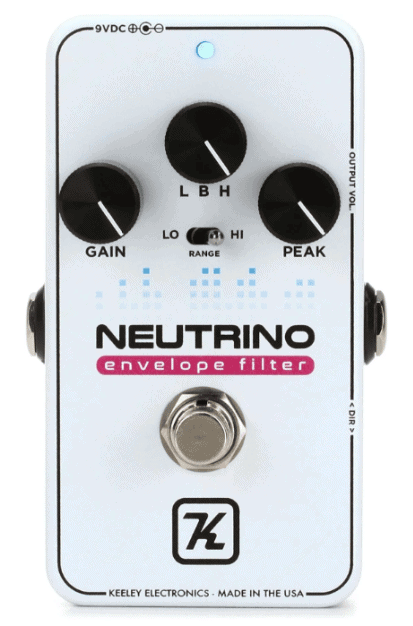
Keeley Neutrino V2
Versatility and quality in a compact unit.
Keeley produces some of the most sought-after pedals in the market today, and their reputation has only grown thanks to high quality and top craftsmanship. The Neutrino V2 remains true to that tradition by offering the user Filter and Auto-wah on a compact and sturdy stompbox.
The Keeley Neutrino V2 comes with completely analog circuitry as well as hand-selected optocouplers for producing a more nuanced dynamic range. The first thing we loved about this pedal is how versatile it is, with three filter types (lowpass, bandpass, and highpass) and two sweep directions.
Despite all of its attributes, this pedal only features three knobs and is very intuitive to use. One of our favorite features was the peak resonance control. This control gave us full command over our chordal sweeps that went from quacky to vowel-like by just turning the knob.
Robert Keeley himself described the Neutrino V2 as “Jerry Garcia in a bottle”. We wanted to put this to the test and dialed in this pedal with every knob at 12 o’clock and the Range toggle set to Lo. Here we got that unmistakable Jerry Garcia auto-wah tone reminiscent of songs like Shakedown Street and so many other Grateful Dead classics.
One of our favorite features on the Neutrino V2 is the Direction switch located on the side. We were able to take this pedal from closed to open (your typical wah sound) to open to closed (more of an “a” to “aw” type sound) all based on our pick attack. In other words, this pedal was highly responsive to our picking, a fantastic feature that makes it that much more musical.
On top of that, the Neutrino V2 comes with a side-mounted output control that makes up for perceived volume drops, and true bypass switching. In short, a fantastic auto-wah pedal. That said, it costs more than some folks may be willing to pay.
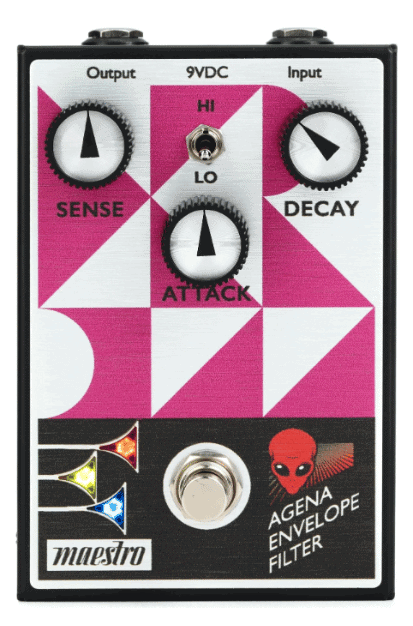
Maestro Agena
A mix of vintage sound and classic looks.
Maestro Pedals bring back some of the most desirable tones from decades ago. The Angena is no exception and delivers classic auto wah on a vintage package and with a classic feel.
The Maestro Agena offers the user classic funky auto-wah tones on a simple design with a vintage touch. We plugged this pedal right into our chain with our Strat and to our Twin Reverb amp and loved how sensitive it was to our playing.
All of its controls were easy to figure out and offer an intuitive user experience. The Attack knob allowed us to determine how quickly the filter opened up, while Decay determined how long the filter stayed open. With the use of just three simple knobs, we got everything from gentle and musical quack to experimental and aggressive filter sweeps.
The Agena also features a switch that let us set the frequency range of the pedal’s envelope to either high or low. With true-bypass switching, intuitive operation, and dynamic response, this pedal is a great choice for folks who gravitate toward more of a vintage tone and vibe. However, if you’re looking for a modern auto-wah pedal, this unit isn’t for you.
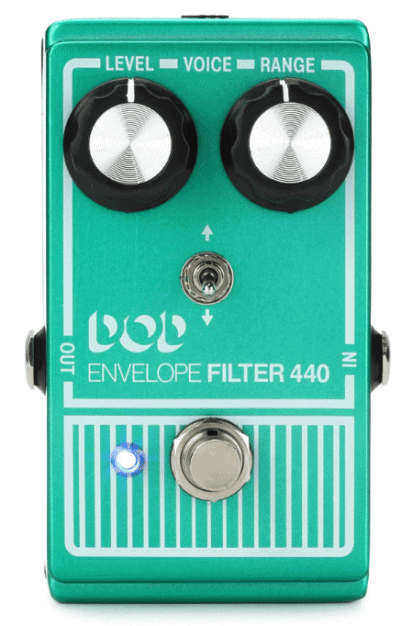
DOD Envelope Filter 440
Simplicity in a dynamic and durable pedal.
This is a reissue of a popular pedal that was known for providing quality auto wah tones. This version brings some enhancements but keeps the quality and tone of the original, at a nice price.
The DOD Envelope Filter 440 is a reissue from this classic pedal, giving you that beloved filter-sweep effect that comes with a new Up/Down Voice switch that lets the user choose what part of the sweep to emphasize.
The first thing we liked about this pedal is that it was very sensitive to our playing. We activated the slow filter sweeps through our pick attack and got a funky auto-wah effect that can come in handy in a variety of contexts. We added a bit of overdrive via our Tube Screamer and found that it matches wonderfully with the Filter 440.
Through the Range control, we were able to pick which frequencies we wanted the filter to sweep, which is a great feature to keep things smooth. However, our favorite feature on this pedal was the Voice switch, which allowed us to pick which part of the sweep got emphasized. The Up setting providing us with that classic 440 guitar effect.
Besides the aforementioned up/down switch, this reissue also brings other new features to the table. For instance, you get a bright blue status LED that gives you a visual reference even in dimly-lit situations. This version of the Filter 440 also comes with a light aluminum chassis, as well as true-bypass switching.
In short, a nice dynamic triggered filter that’s simple to use and ideal for folks who like to get to the point without many features. That said, those who like a bit more control over their tone may want to look elsewhere.
How to Choose the Right Pedal for You
One of the most common and conventional uses for envelope filter pedals is playing funk. They lend a sort of floating and pleasant character to lead lines and chord progressions, and have been used in this context for decades.
Because this effect is triggered by your picking attack, envelope style filters are ideal for fast and staccato-style playing that’s commonplace among guitar players who delve into funk.
We’d be remiss not to mention the legendary Jerry Garcia here. The iconic Grateful Dead guitarist and singer is among the most celebrated pioneers of the effect on guitar.
A good portion of the Grateful Dead’s extensive catalog features this effect prominently. His influence on this field is so great that some pedal manufacturers have Jerry Garcia’s tone in mind when building their pedals.
Below we share a few considerations about these types of pedals:
Where Does It Go In My Chain?
Because a filter pedal is a dynamically-controlled unit that’s used to boost a frequency you sweep up to, it should be placed first in the signal. This type of pedal is much like a regular Wah when it comes to where it belongs in your chain.
And because filters respond to your picking attack, you should avoid limiting its dynamics with compressors, overdrives, and even distortion stompboxes that decrease dynamic range. To make the most out of these pedals, place them at the beginning of your chain.
Modern vs Vintage
Filter pedals have the same debate raging as everything else guitar-related. And just like with guitars and amplifiers, it all depends on your personal taste and what you need it for.
Do you want to get an auto-wah tone, as popularized in the ’70s by plenty of bands? This is a very unique tone and some manufacturers have painstakingly constructed units that can reproduce vintage auto-wah.
On the other hand, if you want a more modern tone that feels current and also gives you a unique sound to make your own, a modern pedal is the way to go.
You could also opt for something that offers the best of both worlds: vintage auto-wah with the option of obtaining modern tones to take you on an experimental journey.
Some folks also opt to have the original piece of gear from decades ago. For that, they’re willing to fork over thousands of dollars, as these pedals haven’t been in production for many years.
Ease of Use
This is another important consideration to keep in mind. The best way to go about it is to ask yourself what you need it for. Perhaps you only want to get that auto-wah tone that can give you a special element to add warble to some of your parts. On the other hand, if you want to go down a rabbit hole of experimentation, you’ll likely need more features.
Naturally, the best and most direct way to find out what you want or need is to try some for yourself. Although this recommendation is made for nearly all gear, it’s particularly important for these pedals.
Price
This consideration is closely tied to the previous one. If you want something simple that delivers a bit of texture to your playing, you won’t have to spend as much. On the other hand, if you’re looking for a unique pedal that helps you further develop your own voice on the guitar, expect to pay more.
Naturally, if you just want to get the best out there, be prepared to splurge. Trying some of these pedals yourself is vital when making an informed choice.
Final Thoughts
For some reason, envelope filter pedals aren’t the most popular among guitar players. They don’t command the amount of thought that, say, distortion or delay pedals do. However, they’re some of the most unique pieces of gear a guitar player can have on his or her pedalboard.
These pedals can deliver everything from soothing auto-wah that can embellish rhythm and lead parts, all the way to otherworldly tones that you can combine with other pedals to produce your very own sound. Whatever the use, these pedals have been around for a long time and are still very much in use nowadays.
To recap our choices, the Fender Pour Over is our Top Choice for this list. It comes with switchable lowpass, bandpass, and highpass filter modes and provides a great response to playing dynamics while providing a useful and tasteful auto-wah effect.
The Electro-Harmonix Nano Q-Tron is our Budget Choice. This pedal gives the user dynamic-controlled wah-wah sounds like its predecessor, but in a more straightforward and compact stompbox that easily fits in a pedalboard. And at a more attractive price tag.
Last but not least, the Way Huge Smalls Attack Vector Phaser and Envelope is our Editor’s Choice. This pedal is a great choice for discerning users. It features two different effects, namely phase shifting and filtering, in a streamlined design and very responsive operation.

